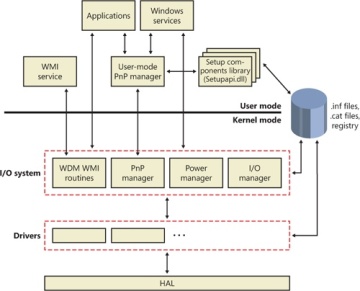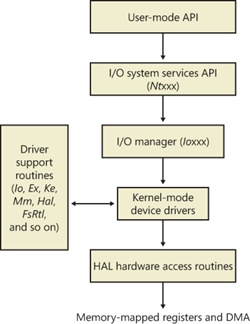Understanding the Windows I/O System
- By Mark E. Russinovich, Kate Chase, Alex Ionescu
- 9/15/2012
The Windows I/O system consists of several executive components that together manage hardware devices and provide interfaces to hardware devices for applications and the system. In this chapter, we’ll first list the design goals of the I/O system, which have influenced its implementation. We’ll then cover the components that make up the I/O system, including the I/O manager, Plug and Play (PnP) manager, and power manager. Then we’ll examine the structure and components of the I/O system and the various types of device drivers. We’ll look at the key data structures that describe devices, device drivers, and I/O requests, after which we’ll describe the steps necessary to complete I/O requests as they move through the system. Finally, we’ll present the way device detection, driver installation, and power management work.
I/O System Components
The design goals for the Windows I/O system are to provide an abstraction of devices, both hardware (physical) and software (virtual or logical), to applications with the following features:
Uniform security and naming across devices to protect shareable resources. (See Chapter 6, “Security,” in Part 1 for a description of the Windows security model.)
High-performance asynchronous packet-based I/O to allow for the implementation of scalable applications.
Services that allow drivers to be written in a high-level language and easily ported between different machine architectures.
Layering and extensibility to allow for the addition of drivers that transparently modify the behavior of other drivers or devices, without requiring any changes to the driver whose behavior or device is modified.
Dynamic loading and unloading of device drivers so that drivers can be loaded on demand and not consume system resources when unneeded.
Support for Plug and Play, where the system locates and installs drivers for newly detected hardware, assigns them hardware resources they require, and also allows applications to discover and activate device interfaces.
Support for power management so that the system or individual devices can enter low power states.
Support for multiple installable file systems, including FAT, the CD-ROM file system (CDFS), the Universal Disk Format (UDF) file system, and the Windows file system (NTFS). (See Chapter 12, for more specific information on file system types and architecture.)
Windows Management Instrumentation (WMI) support and diagnosability so that drivers can be managed and monitored through WMI applications and scripts. (WMI is described in Chapter 4, “Management Mechanisms,” in Part 1.)
To implement these features the Windows I/O system consists of several executive components as well as device drivers, which are shown in Figure 8-1.
The I/O manager is the heart of the I/O system. It connects applications and system components to virtual, logical, and physical devices, and it defines the infrastructure that supports device drivers.
A device driver typically provides an I/O interface for a particular type of device. A driver is a software module that interprets high-level commands, such as read or write, and issues low-level, device-specific commands, such as writing to control registers. Device drivers receive commands routed to them by the I/O manager that are directed at the devices they manage, and they inform the I/O manager when those commands are complete. Device drivers often use the I/O manager to forward I/O commands to other device drivers that share in the implementation of a device’s interface or control.
The PnP manager works closely with the I/O manager and a type of device driver called a bus driver to guide the allocation of hardware resources as well as to detect and respond to the arrival and removal of hardware devices. The PnP manager and bus drivers are responsible for loading a device’s driver when the device is detected. When a device is added to a system that doesn’t have an appropriate device driver, the executive Plug and Play component calls on the device installation services of a user-mode PnP manager.
The power manager also works closely with the I/O manager and the PnP manager to guide the system, as well as individual device drivers, through power-state transitions.
Windows Management Instrumentation support routines, called the Windows Driver Model (WDM) WMI provider, allow device drivers to indirectly act as providers, using the WDM WMI provider as an intermediary to communicate with the WMI service in user mode. (For more information on WMI, see the section “Windows Management Instrumentation” in Chapter 4 in Part 1.)
The registry serves as a database that stores a description of basic hardware devices attached to the system as well as driver initialization and configuration settings. (See “The Registry” section in Chapter 4 in Part 1 for more information.)
INF files, which are designated by the .inf extension, are driver installation files. INF files are the link between a particular hardware device and the driver that assumes primary control of the device. They are made up of script-like instructions describing the device they correspond to, the source and target locations of driver files, required driver-installation registry modifications, and driver dependency information. Digital signatures that Windows uses to verify that a driver file has passed testing by the Microsoft Windows Hardware Quality Labs (WHQL) are stored in .cat files. Digital signatures are also used to prevent tampering of the driver or its INF file.
The hardware abstraction layer (HAL) insulates drivers from the specifics of the processor and interrupt controller by providing APIs that hide differences between platforms. In essence, the HAL is the bus driver for all the devices soldered onto the computer’s motherboard that aren’t controlled by other drivers.

Figure 8-1 I/O system components
The I/O Manager
The I/O manager is the core of the I/O system because it defines the orderly framework, or model, within which I/O requests are delivered to device drivers. The I/O system is packet driven. Most I/O requests are represented by an I/O request packet (IRP), which travels from one I/O system component to another. (As you’ll discover in the section Fast I/O, fast I/O is the exception; it doesn’t use IRPs.) The design allows an individual application thread to manage multiple I/O requests concurrently. An IRP is a data structure that contains information completely describing an I/O request. (You’ll find more information about IRPs in the section I/O Request Packets later in the chapter.)
The I/O manager creates an IRP in memory to represent an I/O operation, passing a pointer to the IRP to the correct driver and disposing of the packet when the I/O operation is complete. In contrast, a driver receives an IRP, performs the operation the IRP specifies, and passes the IRP back to the I/O manager, either because the requested I/O operation has been completed, or because it must be passed on to another driver for further processing.
In addition to creating and disposing of IRPs, the I/O manager supplies code that is common to different drivers and that the drivers can call to carry out their I/O processing. By consolidating common tasks in the I/O manager, individual drivers become simpler and more compact. For example, the I/O manager provides a function that allows one driver to call other drivers. It also manages buffers for I/O requests, provides timeout support for drivers, and records which installable file systems are loaded into the operating system. There are close to one hundred different routines in the I/O manager that can be called by device drivers.
The I/O manager also provides flexible I/O services that allow environment subsystems, such as Windows and POSIX, to implement their respective I/O functions. These services include sophisticated services for asynchronous I/O that allow developers to build scalable, high-performance server applications.
The uniform, modular interface that drivers present allows the I/O manager to call any driver without requiring any special knowledge of its structure or internal details. The operating system treats all I/O requests as if they were directed at a file; the driver converts the requests from requests made to a virtual file to hardware-specific requests. Drivers can also call each other (using the I/O manager) to achieve layered, independent processing of an I/O request.
Besides providing the normal open, close, read, and write functions, the Windows I/O system provides several advanced features, such as asynchronous, direct, buffered, and scatter/gather I/O, which are described in the Types of I/O section later in this chapter.
Typical I/O Processing
Most I/O operations don’t involve all the components of the I/O system. A typical I/O request starts with an application executing an I/O-related function (for example, reading data from a device) that is processed by the I/O manager, one or more device drivers, and the HAL.
As just mentioned, in Windows, threads perform I/O on virtual files. A virtual file refers to any source or destination for I/O that is treated as if it were a file (such as files, directories, pipes, and mailslots). The operating system abstracts all I/O requests as operations on a virtual file, because the I/O manager has no knowledge of anything but files, therefore making it the responsibility of the driver to translate file-oriented comments (open, close, read, write) into device-specific commands. This abstraction thereby generalizes an application’s interface to devices. User-mode applications (whether Windows or POSIX) call documented functions, which in turn call internal I/O system functions to read from a file, write to a file, and perform other operations. The I/O manager dynamically directs these virtual file requests to the appropriate device driver. Figure 8-2 illustrates the basic structure of a typical I/O request flow.

Figure 8-2 The flow of a typical I/O request
In the following sections, we’ll look at these components more closely, covering the various types of device drivers, how they are structured, how they load and initialize, and how they process I/O requests. Then we’ll cover the operation and roles of the PnP manager and the power manager.